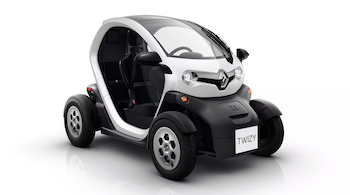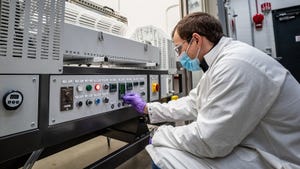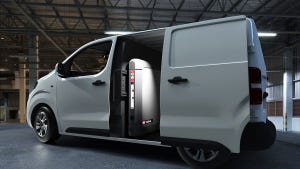The Battery Show & EV Tech Europe Digital Days: Philippe Gyan of Renault Talks Battery Management Systems
Gyan's talk is titled “Battery Management Systems: Effectively Managing Aging of the Battery and Extending the Durability”.
May 15, 2021

The Battery Show & EV Tech Europe Digital Days on May 18-20 is an interactive virtual conference delivering the same technical training, top-tier education, and expert speakers from our in-person events, but in an easily digestible virtual format.
Among the featured presentation during the show will be a talk titled “Battery Management Systems: Effectively Managing Aging of the Battery and Extending the Durability” by Philippe Gyan, Innovation Pilot Battery System Modelling Research Engineer, at the automaker Renault. Battery Technology caught up with Dr. Gyan to find out more about his talk.

Battery Technology: Can you first give us a brief biography? Why are you interested in the electrification of transportation? Why did your career move in this direction?
Gyan: After my graduation with a Ph.D. in 2003 from Ecole Centrale de Lyon in Mechanical Engineering, Thermal and Energy Management, I was responsible for performances and fuel economy calculation at Renault Advanced Engineering division, then I joined the Research division in 2008, for electric powertrain sizing, battery thermo-electrical, and aging modeling.
My main activity is electrical, thermal, and durability modeling of batteries.
I don’t dive into the electrochemical part, I consider the cells once they are produced, with modeling based on a data-driven approach.
I chose the path towards electrification as the first electric vehicles were being designed, I worked directly on Twizy and Kangoo. This career direction was motivated by the strong vision to make mobility more clean, environment friendly, and to preserve the planet’s resources for the future generations. I lead the project MOBICUS (2014-2018) on Battery aging testing and modeling.
BT: Does battery chemistry (LFP, NMC) have a big effect on battery lifetimes? Does this give a financial advantage of one compared to the other?
Gyan: Yes, each chemistry has specific characteristics about voltage range, energy density, and expected durability. Even within a same family of chemistry, the characteristics can be different, according to the choice of raw materials for electrodes, additives, thickness of electrodes, manufacturing process, formation during initial cycles.
Aging characteristics from various cells have been measured and modeled in the SIMCAL project. The set of equations is the same for the different chemistries, the calibration is specific for each one.
Generally, LFP is considered to be more durable than NMC, yet it has less energy density.
A technical-economical balance has then to be found for each vehicle project, between available driving range, safety, energy density, chargeability, durability, thermal behavior, cost, environmental footprint. LFP is a cobalt-free technology, has also a ”flat“ voltage behavior, which requires more accuracy for State of Charge estimation techniques, and remaining range prediction
BT: How well do present simulations model actual battery aging behavior? What needs to be done to improve this?
Gyan: Some aging models are based on the number of cycles, on discharged energy, on driven kilometers…
These approaches have their limitations :
With aging, the energy in a cycle may decrease, the duration of the discharge is not the same, the thermal rise changes, therefore a cycle is a variable unit during time.
Some considerations about aging are not intuitive: a vehicle can stay parked up to 95% of real-time. Therefore, aging occurs the most during calendar mode. A vehicle staying parked at full charge in a warm environment will have more battery aging than a vehicle being used, receiving partial charge, and staying parked in a mild environment (underground parking).
A driver, with a careful driving style and recharging the battery whenever he cans, will see more battery aging than a customer with an aggressive driving style, and charging once a week.
With the MOBICUS project, major improvements have been achieved with the strong coupling of electric – thermal and aging models, in order to represent accurately battery ageing in real usage conditions. The approaches have been transposed to other cell references and applied on real field data, with more than 3 years of history. The methods have allowed us to perform sensitivity analysis to determine optimal charging strategies and evaluate the economical benefits for the user.
Some improvements may apply to detect and prevent sudden death, as observed on test benches in severe conditions. Models have been established, yet the calibration for different temperature and usage conditions requires very lengthy tests.
Battery lifetime estimation is not just about the chemistry of the cell, it involves also the environment ambient temperature conditions, the driving patterns, the charging strategies, the parking conditions. Applying relevant durability strategies may improve the battery life by more than 50 %, for the exact same vehicle usage

BT: Will EVs in harsh environments (extreme heat, extreme cold) need special monitoring capabilities to maintain good battery life? Would we expect battery life to be shorter in these harsh extremes?
Gyan: In extreme heat, the battery life is shortened by calendar aging, and cycling effect has less influence, as there is less temperature rise since resistance is smaller. In extreme cold, calendar aging is very small, yet, since resistance is much more important, cycling aging induces more degradation to the battery, with greater heat generation and risks of lithium plating.
In both cases, it is required that the BMS (Battery Management System) would manage the current, voltage, power, State of Charge (SOC) limitations according to temperature and durability targets. Special attention has to be brought to the definition of State of Charge according to temperature. Unmanaged currents in harsh temperature conditions may lead to anticipated battery degradation.
Therefore, it is better to avoid leaving a battery fully charged under the sun for extended periods of time (vehicle on an airport parking lot), one solution is to leave the battery at partial charge, with enough energy to drive to the destination, or to a fast-charging station
It is also better not to attempt fast charging at full power when the battery is cold, at subzero temperatures. Durability strategies will then limit the maximal power and trigger thermal management to warm up the battery.
BT: How does Fast DC charging affects battery life?
Gyan: Most of the aging occurs in calendar mode, The battery life is affected mainly by the State of Charge at the end of the charge, and the duration between the end of the charge and the next driving event.
DC fast charging will generate heat, which would need to be dissipated by the thermal management system, even beyond the end of the charging event. Aiming to charge at 100 % will increase the duration of the charging, during the CV (constant voltage) phase, and the battery degradation that occurs at high temperature and a high state of charge. Fast charging may be used up to a SOC around 80% in warm conditions and is relevant when the vehicle drives again shortly after the end of the charge.
Aging between slow charge and fast charge should be compared on sequences of the same duration.
If the fast charge has the same initial time as the slow charge, the aging will be more important for the fast charge, since the battery will be at a higher temperature and a higher SOC for a longer period of time
If the fast charge has the same final time as the slow charge, aging might be more important for the slow charge, according to the cell aging characteristics. The SOC profile for the slow charge over the full sequence will be at a higher level than the SOC profile of the fast charge
BT: On a bigger scale, how do you see the rollout of electrification of transportation in Europe?
Gyan: The electrification of transportation is in progress, plug-in vehicles (PHEV and BEV) represent more than 10 % of the market in 2020, in Norway, more than half of the vehicles sold are electrified. OEMs are preparing a wider offer of vehicles from different segments, which can cover more of the specific needs of customers, with SUV, delivery vehicles. In some countries, thermal vehicles will be banned as early as 2025.
One major limitation for the electrification rollout is the deployment of public charging infrastructure. Standardization has now been reached. Issues need to be solved to favor the adoption of electrified vehicles such as the interoperability of charging systems, the diversity of the charge pricing, solutions for customers living in apartments, compared to house owners.
Incentives have been put on hydrogen transportation combined with energy storage in batteries. The hydrogen distribution network needs to be developed.
Electrification can have even more potential towards CO2 footprint reduction when coupled with Vehicle to Grid, and the use of renewable energies. The vehicle is not just for transportation, it will represent also a mobile energy storage device. The electrification of transportation needs to be addressed at the ecosystem level.
Dr. Philippe Gyan will present “Battery Management Systems: Effectively Managing Aging of the Battery and Extending the Durability” on Wednesday, May 19, 2021, from 9:45 am - 10:15 am (Central European Time).
The Battery Show & EV Tech Europe Digital Days provides the latest in advanced battery design, thermal management, the evolution of battery chemicals, and other hot topics all from the comfort of wherever you are. You can check out the agenda at a glance below for more details.
Speaking companies include Volvo, EIT InnoEnergy, Williams Advanced Engineering, and The Faraday Institute. See the full list of speakers here, and then click the link below to get your pass.
Kevin Clemens is a Senior Editor with Battery Technology.
About the Author(s)
You May Also Like





